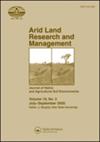Lasiurus sindicus Henr., a key perennial fodder grass for desert ecosystem
IF 1.6
4区 农林科学
Q3 ENVIRONMENTAL SCIENCES
引用次数: 0
Abstract
Abstract Lasiurus sindicus Henr. is one of the most prominent grass species, occupying 80% area of the desert grassland. Average dry forage production of L. sindicus at the mature stage is 2.5–3.5 t ha−1 (with 93% dry matter, 4.6% crude protein, 31% crude fiber, and 4.5% ash) and the carrying capacity of L. sindicus grasslands ranges from 0.8 to 1.2 active cattle units ha−1 in the normal rainfall years. A large number of diazotrophs, as well as endophytes, have been found associated with L. sindicus rhizosphere, which play a crucial role in maintaining the plant-soil ecological interaction. L. sindicus has a prominent place as a perennial component in silvo-pastural, agro-pastural, agro-silvo-pastural, and horti-pastural production systems. Considering its importance, much emphasis should be given to utilization of L. sindicus based grasslands according to their carrying capacity and to avoid overgrazing.拉西乌斯·辛迪乌斯·亨利。是荒漠生态系统重要的多年生草料
摘要:黄鼠狼。是最突出的草种之一,占荒漠草原面积的80%。成熟期羊草的平均干饲料产量为2.5 ~ 3.5 t ha - 1(干物质93%,粗蛋白质4.6%,粗纤维31%,灰分4.5%),正常降雨年份羊草草地的承载能力为0.8 ~ 1.2活牛单位ha - 1。在L. sinindicus根际中发现了大量重氮营养菌和内生菌,它们在维持植物-土壤生态相互作用中起着至关重要的作用。在农牧、农牧、农牧-农牧、农牧-农牧和园牧生产系统中,L. sinindicus作为多年生植物具有突出的地位。鉴于其重要性,应根据其承载能力重视对羊草草地的利用,避免过度放牧。
本文章由计算机程序翻译,如有差异,请以英文原文为准。
求助全文
约1分钟内获得全文
求助全文
来源期刊

Arid Land Research and Management
环境科学-环境科学
CiteScore
3.80
自引率
7.10%
发文量
23
审稿时长
9 months
期刊介绍:
Arid Land Research and Management, a cooperating journal of the International Union of Soil Sciences , is a common outlet and a valuable source of information for fundamental and applied research on soils affected by aridity. This journal covers land ecology, including flora and fauna, as well as soil chemistry, biology, physics, and other edaphic aspects. The journal emphasizes recovery of degraded lands and practical, appropriate uses of soils. Reports of biotechnological applications to land use and recovery are included. Full papers and short notes, as well as review articles and book and meeting reviews are published.
 求助内容:
求助内容: 应助结果提醒方式:
应助结果提醒方式:


